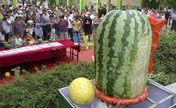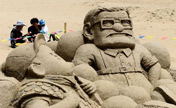

At a conference in Xi'an, archaeologists discuss how the digitalization of historical sites and relics help recreate communities, allowing them to look into the past and see the future. But experts warn data preservation can face challenges, Cheng Yingqi reports.
Being an archaeologist can be boring. Hours of digging square holes in the ground and filling out paperwork, right? That may have been true in the past, but archaeology is more than just about the past, it helps us understand the future. And today's practitioners, with computers and state-of-the-art cameras, would not consider their work boring. "Heritage is not always immortal, it can vanish, but information lasts forever," said Professor Lu Dongming at Zhejiang University. "Excavating and preserving relics is no longer the sole purpose of archaeological digs. All information should be recorded during the process. In fact, digital documentation is as important as preservation," said Lu, who specializes in applying computer technology to archaeological studies.
In the past 30 years some 40,000 cultural treasures have been lost to future generations, more than 50 percent of which destroyed by construction, China News Agency reported in June, citing the Ministry of Culture.
One attempt to use new technology to preserve vanishing sites is an ambitious plan by Dunhuang Academy to digitally recreate the Mogao Grottoes in Gansu province.
The grottoes, China's first UNESCO World Heritage Site, gained global recognition for their collection of Buddhist artworks - more than 2,000 colored sculptures and 45,000 square meters of frescoes in 735 caves carved along a cliff by worshippers.
However, climate change coupled with increasing tourist numbers has resulted in the deterioration of the frescoes, so scientists had to photograph them to make sure they were recorded.
Besides high-accuracy photography, laser 3-D scanners are used for digital recording. This process is especially valuable for stone tablets, said Ding Yao at the Tianjin University School of Architecture.
"Traditionally, we made rubbings to record information on stone tablets. However, in some cases the writing on old tablets is indistinct," he said. "But laser scanners can help us read and see all the artwork."
The digitalization of historical sites and relics is not just about data. It helps recreate the society or community at that time, allowing scientists to look into the past and see the future.
One of the most interesting examples is the Stanford Geospatial Network Model of the Roman World, a collaboration between historians and information technology specialists at Stanford University.
Based on digitalized archaeological information, the model calculates the time, expenses of people traveling through the Roman Empire.
China's first international conference on excavation documentation was held in Xi'an, capital of Shaanxi province, in May. It attracted 105 archaeologists from home and abroad.
"Since Shaanxi is very rich in buried relics and artifacts, high-tech methods applied here helped us to improve the level of archaeological documentation," said Guo Xianzeng, deputy director of the provincial cultural heritage administration.
"The archaeological community in China is experiencing explosive growth in digitalizing," he said.
 |
 A letter to China's first space teacher
A letter to China's first space teacher Taiwan guests attend 5th Straits Forum
Taiwan guests attend 5th Straits Forum Protesters stage anti-gov't rally in Bangkok
Protesters stage anti-gov't rally in Bangkok World Naked Bike Ride kicks off in Vancouver
World Naked Bike Ride kicks off in Vancouver Los Angeles' Chinatown sets up statue of Bruce Lee
Los Angeles' Chinatown sets up statue of Bruce Lee Touching moments of fathers with kids
Touching moments of fathers with kids Watermelon weighing 50 kilograms takes the crown
Watermelon weighing 50 kilograms takes the crown China Railway to push freight transport services
China Railway to push freight transport services Farmers burn wheat stubble despite ban
Farmers burn wheat stubble despite ban  16th Shanghai Int'l Film Festival kicks off
16th Shanghai Int'l Film Festival kicks off Sand sculptures at scenery spot of Qinghai Lake
Sand sculptures at scenery spot of Qinghai Lake 4th Int'l Festival of Intangible Cultural Heritage
4th Int'l Festival of Intangible Cultural Heritage Whole night queue for public kindergartens
Whole night queue for public kindergartens 24th China Harbin Int'l Economic & Trade Fair
24th China Harbin Int'l Economic & Trade Fair 1st direct int'l airline to Europe from NW China
1st direct int'l airline to Europe from NW China